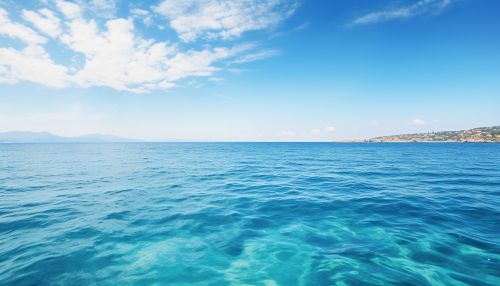Mediterranean Sea
Geography
The Mediterranean Sea is a sea connected to the Atlantic Ocean, surrounded by the Mediterranean Basin and almost completely enclosed by land: on the north by Southern Europe and Anatolia, on the south by North Africa, and on the east by the Levant. The sea is technically a part of the Atlantic Ocean, although it is usually identified as a separate body of water.


The Mediterranean Sea covers an approximate area of 2.5 million square kilometers. It is connected to the Atlantic Ocean by the Strait of Gibraltar in the west and to the Sea of Marmara and the Black Sea, by the Dardanelles and the Bosporus respectively, in the east. The 163 km (101 mi) long artificial Suez Canal in the southeast connects the Mediterranean Sea with the Red Sea.
Physical and environmental characteristics
The Mediterranean Sea has an average depth of 1,500 m and the deepest recorded point is 5,267 m in the Calypso Deep in the Ionian Sea. The coastline extends for 46,000 km. A unique feature of the Mediterranean Sea is its characteristic deep blue color, which is due to its clear, high salinity waters.
The Mediterranean Sea is known for its variable climate, with seasonal temperature and precipitation changes. The climate is a typical Mediterranean climate with hot, dry summers and mild, rainy winters. The sea's temperature ranges from 10°C to 27°C, depending on the season and location.
The sea is also known for its strong tides caused by the gravitational pull of the moon and sun. These tides, along with the warm temperature, make the Mediterranean Sea a hot spot for biodiversity. The sea is home to a diverse array of marine life, including over 700 species of fish and numerous species of marine mammals.
History
The history of the Mediterranean Sea is rich and complex. It has been a central route for maritime migrations, as well as a battlefield for territorial disputes. The sea's name derives from the Latin 'Mediterraneus', meaning "inland" or "in the middle of the land". It reflects the sea's position between the continents of Africa, Asia, and Europe.
The Mediterranean Sea has been influential in the development of the civilizations that flourished around its rim. The earliest civilizations, including the Egyptians, Phoenicians, Greeks, and Romans, have left their mark on the region through various archaeological sites and monuments.
In the Middle Ages, the Mediterranean Sea was a key route for trade and warfare, and it played a central role in the history and culture of the region. The Renaissance saw an increase in exploration and trade in the Mediterranean, leading to a period of great wealth and cultural exchange.
The modern history of the Mediterranean is dominated by the impact of World War II, the rise of tourism, and ongoing issues such as territorial disputes, environmental degradation, and the migration crisis.
Economy
The Mediterranean Sea plays a crucial role in the economy of the surrounding countries. It provides routes for trade and transportation, and its coastal and marine resources are key assets for the region's economy.
The sea is a major route for merchant ships, with numerous ports along its coasts. Some of the world's busiest shipping lanes are in the Mediterranean Sea, including the route through the Suez Canal, which connects Europe with Asia.
Tourism is another major economic activity. The Mediterranean region is one of the world's most popular tourist destinations, attracting millions of visitors each year. The region's mild climate, beautiful landscapes, and rich history make it a popular choice for tourists.
Fishing is also an important economic activity in the Mediterranean. The sea provides a wide variety of fish and shellfish, contributing to the local economies and diets of the surrounding countries.
Environmental issues
The Mediterranean Sea faces several environmental challenges, including overfishing, pollution, habitat destruction, and climate change. These issues have led to a decline in biodiversity and have had negative impacts on the health of the sea and its marine life.
Overfishing is a major concern, with many fish species being overexploited. Pollution, particularly from industrial and agricultural runoff, is another major issue. This pollution can lead to eutrophication, which depletes oxygen levels in the water and can lead to the death of marine life.
Habitat destruction, particularly of coastal and marine habitats, is also a significant issue. This is often due to development for tourism and other human activities.
Climate change is another major threat to the Mediterranean Sea. Rising temperatures can lead to changes in sea level and can affect marine life, including fish species that are important for the region's economy.
